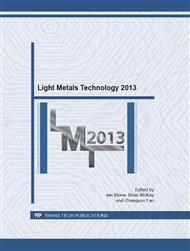p.220
p.225
p.230
p.235
p.241
p.245
p.250
p.255
p.260
Material Properties of Cast Aluminium Alloys Produced by Various Casting Processes
Abstract:
The material and mechanical properties of cast aluminium alloys, produced using various casting technologies, have been investigated experimentally. In this study, several casting processes were selected, including gravity casting (GC), cold-chamber diecasting (CD), hot-chamber diecasting (HD), squeeze diecasting (SQ), twin rolled continuous casting (TRC) and heated mould continuous casting (HMC). Although all cast samples were made of the same aluminium alloy of Al-Si-Cu (ADC12), different material properties were obtained, in particular microstructural characteristics, crystal orientation and residual stress. In this instance, the microstructures of the GC and CD samples were formed mainly of coarse α-Al phase and needle-shaped eutectic structures; and a microstructure of fine round grain and tiny eutectic structures were observed for the HC, TRC and HMC samples. On the other hand, spherical shaped α-Al phase with a relatively large size was detected in SQ. The different microstructural characteristics led to different mechanical properties. A uniformly orientated lattice structure was detected in the HMC and SQ samples, which gave high material ductility. High internal compressive stress high dislocation density, arising from the rolling process, led to the high tensile properties for the TRC procedure. Various cast defects, such as blow holes and shrinkage porosity, were detected in GC and CD, which gave a reduction in their tensile properties.
Info:
Periodical:
Pages:
241-244
Citation:
Online since:
July 2013
Authors:
Keywords:
Price:
Сopyright:
© 2013 Trans Tech Publications Ltd. All Rights Reserved
Share:
Citation:


